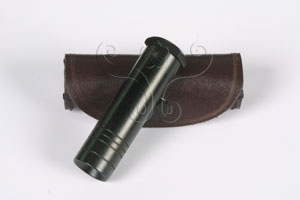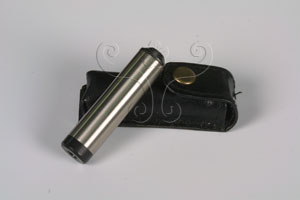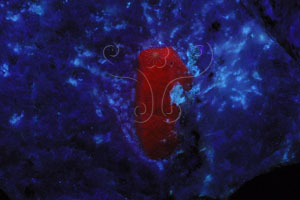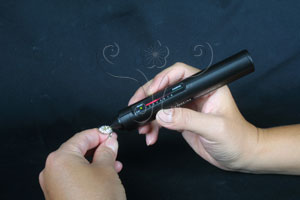|
01 Magnifying glass and microscope
Since most precious stones are small in size, in order to better observe the imperfections such as inclusions and fractures on the gemstones, microscopes and magnifying glasses are employed. A microscope with 10X or 20X magnifications is usually used to observe the gemstones; for more detailed observations, magnification up to 70X can be used. Aside from observing inclusions and fractures, these instruments can be used to observe the cleavage planes, growth lines, color bandings, surface graining, and the degree of external polishing. Sometimes they can also identify layers of assembled stones.
 |
|
Usually a magnifying glass is placed about 1 inch in front of the eye to observe.
|
02 Refractometer
The refractive index is an important optical property of transparent gemstones and is also an important indicator of gemstone authentication. A refractometer measures the total internal refraction of a gemstone, and can identify gemstones with RI in the range between 1.30 to 1.81. However, stones that have high RI (such as diamonds, zircons and garnets) cannot be properly identified with a refractometer. This instrument can measure the single RI and birefringence of faceted gemstones, and can also measure the RI of convex surface gemstones with point measurement.
 |
| Refractometer can identify gemstones with 1.30~1.81 refractive index. |
03 Dichroscope
The dichroscope is the preferred type of instrument to inspect gemstones with pleochroisms. A calcite rhomb (Iceland spar) separates the polarized light rays that pass through the gemstones and displays the pleochroism on viewing screens. Dichroscope is usually used to identify gemstones that are transparent and isotropic. When using a dichroscope, the gemstones are constantly turned until two colors with the biggest differences show up on the windows; for gemstones with weaker dichroism, a polariscope should be used in conjunction with the dichroscope to further identify the stone.
 |
|
Dichroscope is the preferred instrument to inspect gemstones with pleochroisms.
|
04 Polariscope
A polariscope is composed of two polarized filters with their virational plane perpendicular to each other. When the vibrational plane of the polarizers is at right angles, light cannot pass through. This property is used to test whether a gemstone is homogenic or pleochroic. When turning the stone sample in a polariscope, a bright field indicates it is an aphanitic aggregate; black indicates that the sample is homogenous. If the sample blinks 4 times (light and dark) during a 360° rotation, then the sample is non homogenous.
 |
| Polariscope can test whether a gemstone is homogenic or pleochroic. |
05 Spectroscope (prism)
The spectroscope is made up of a set of prisms, which breaks up the natural white light into a continuous visible spectrum (red, orange, yellow, green, blue, indigo and violet). A discontinuous absorption spectrum is obtained when observing a gemstone under a spectroscope. Since each element has its own specific absorption wavelengths in the spectrum, we can identify gemstones based on their absorption of the visible spectrum, which give rise to unique colors and characteristics.
 |
| Spectroscope can test the absorption wavelengths of a gemstone. |
06 UV light
Fluorescent light sources, while incapable of directly identifying gemstone types, are still effective tools used in authentication. Rubies and pyropes appear red under natural light; however when they are exposed under UV light, only rubies emit red fluorescence (due to the presence of chromium ions). This is one way UV light can be used to sort between different gemstones.
 |
 |
| Ruby |
Under UV light, a ruby emits red fluorescence. |
07 Diamond thermal probes
Built specifically to identify diamonds, this instrument measures the thermal conductance in gemstones. Since most gemstones lack or have very poor thermal conductivity, this instrument can accurately detect diamonds from replicas or other minerals, owing to their excellent thermal conductivity.
 |
| Diamond thermal probes are designed specifically to identify diamonds. |
08 Chelsea Color filter
This tool was developed on the basis that all materials have their own specific absorption wavelengths of the visible light spectrum. It can be used to identify gemstones and determine whether or not they have been artificially processed. The Chelsea filter is composed of two filters that only lets the red and yellow-green portion of the white light pass through it, and is effective in identifying dyed jadeites, gemstones or artificial precious stones. For example, natural emeralds appear red under the Chelsea filter, while other green gemstones may appear green only; jadeites will show up as green, while dyed jadeites and chalcedony will appear pinkish. Although it is a convenient and simple tool to use, the Chelsea filter cannot accurately identify a gemstone, which is why it is most often used as an adjunct to other more sophisticated methods.
 |
| Chelsea color filters are effective in identifying dyed jadeites and other gemstones as well as synthetic diamonds. |
The international digital archives and e-learning communication project of the National Museum of Natural Science
National Museum of Natural Science
|





















